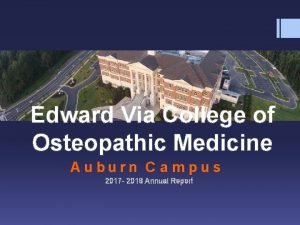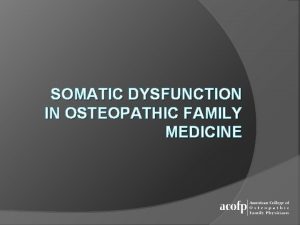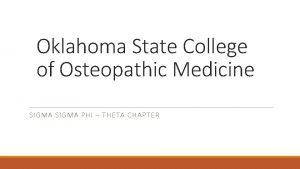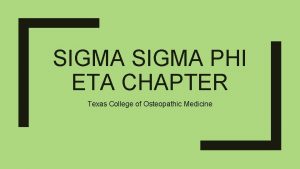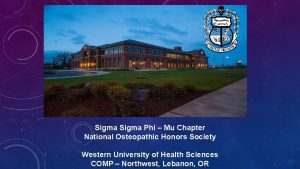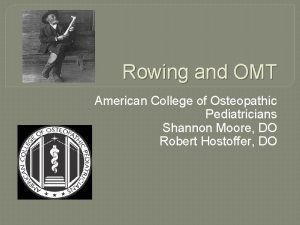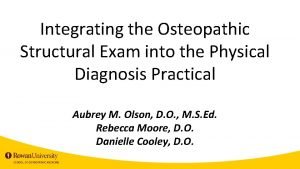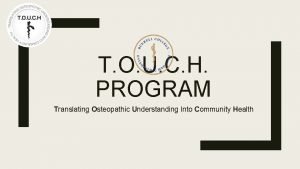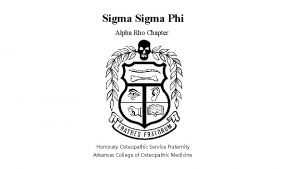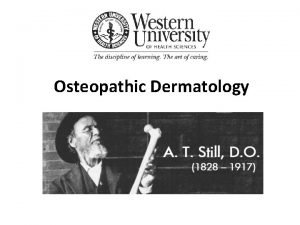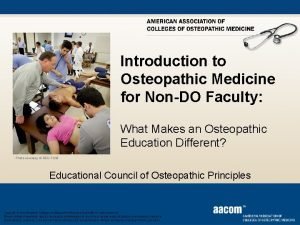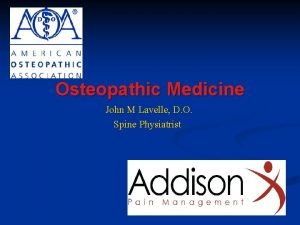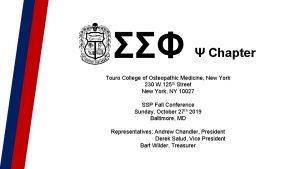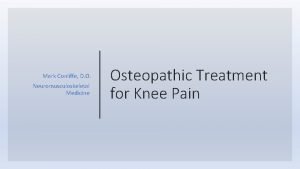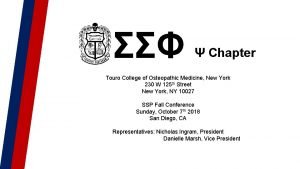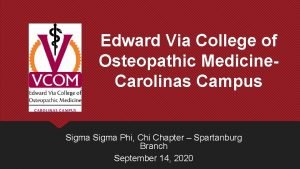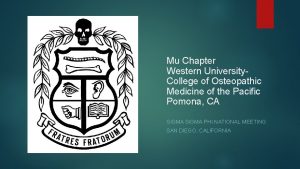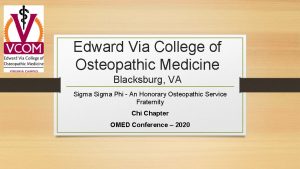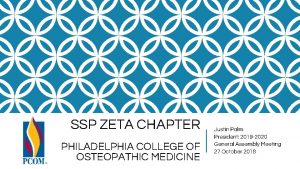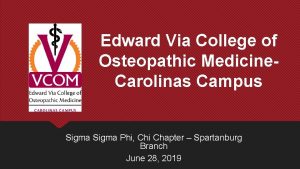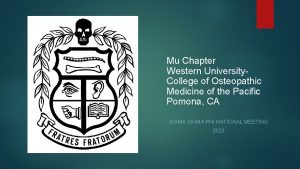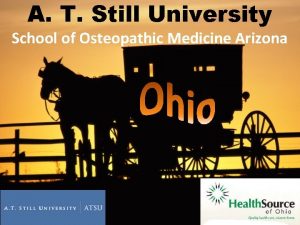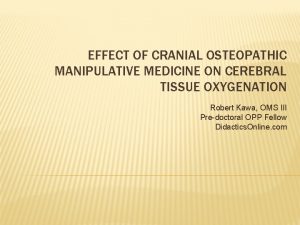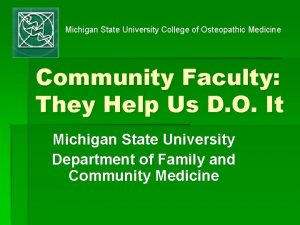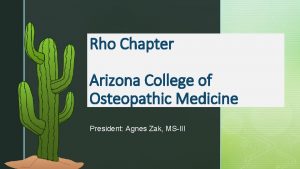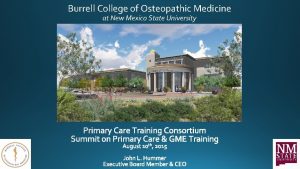OSTEOPATHIC MEDICINE 101 Introduction to Osteopathic Medicine for
















































- Slides: 48

OSTEOPATHIC MEDICINE 101 Introduction to Osteopathic Medicine for Allopathic Physicians STFM Annual Meeting May, 2008 Baltimore, MD

OSTEOPATHIC MEDICINE • Uniquely American • Andrew Taylor Still – A visionary – Disillusioned – Sought a better way to heal patients • Pioneered concept of wellness

OSTEOPATHIC MEDICINE • A philosophy, a science and an art

OSTEOPATHIC MEDICINE • A philosophy, a science and an art • Embraces concept of unity of body structure and function in health and disease

OSTEOPATHIC MEDICINE • A philosophy, a science and an art • Embraces concept of unity of body structure and function in health and disease • Health based on body’s natural capacity to resist and combat noxious influences

OSTEOPATHIC MEDICINE • A philosophy, a science and an art • Embraces concept of unity of body structure and function in health and disease • Health based on body’s natural capacity to resist and combat noxious influences • Disease begins when natural capacity is upset

OSTEOPATHIC MEDICINE • A philosophy, a science and an art • Embraces concept of unity of body structure and function in health and disease • Health based on body’s natural capacity to resist and combat noxious influences • Disease begins when natural capacity is upset • Deal with patient as well as disease

OSTEOPATHIC PHYSICIANS • Work in partnership with their patients • Focus on osteopathic principles when providing medical care to patients

OSTEOPATHIC PRINCIPLES Human Body

OSTEOPATHIC PRINCIPLES Unit of Mind, Body and Spirit Human Body

OSTEOPATHIC PRINCIPLES Unit of Mind, Body and Spirit Human Body Structure and Function are Reciprocally Interrelated

OSTEOPATHIC PRINCIPLES Unit of Mind, Body and Spirit Capable of Self-regulation Self-healing Health maintenance Human Body Structure and Function are Reciprocally Interrelated

OSTEOPATHIC PRINCIPLES Capable of Self-regulation Self-healing Health maintenance Unit of Mind, Body and Spirit Human Body Structure and Function are Reciprocally Interrelated Rational Treatment Based on understanding of these Osteopathic principles

COMPONENTS OF ILLNESS Musculoskeletal Component: muscle pain, low back pain, somatic reflex, etc. MUSCULOSKELETAL COMPONENT MEDICAL DIAGNOSIS/ DISEASE COMPONENT Medical Diagnosis / Disease Component: asthma, kidney stone, ileus, etc.

COMPONENTS OF ILLNESS (KS) Musculoskeletal Component: muscle pain, low back pain, somatic reflex, etc. MUSCULOSKELETAL COMPONENT MEDICAL DIAGNOSIS/ DISEASE COMPONENT Medical Diagnosis / Disease Component: asthma, kidney stone, ileus, etc.

COMPONENTS OF ILLNESS (LBP) Musculoskeletal Component: muscle pain, low back pain, somatic reflex, etc. MUSCULOSKELETAL COMPONENT MEDICAL DIAGNOSIS/ DISEASE COMPONENT Medical Diagnosis / Disease Component: asthma, kidney stone, ileus, etc.

COMPONENTS OF ILLNESS Musculoskeletal Component: muscle pain, low back pain, somatic reflex, etc. MUSCULOSKELETAL COMPONENT Treated with OMT Treated with many modalities: medicine, rest, surgery, physical therapy, psychotherapy MEDICAL DIAGNOSIS/DISEASE COMPONENT Medical Diagnosis / Disease Component: asthma, kidney stone, ileus, etc.

OSTEOPATHIC FACTOID Osteopathic physicians are one of the fastest growing segments of health care clinicians 1994 15 colleges of osteopathic medicine 2008 23 colleges with 3 additional branch campuses Additional colleges on the horizon

OSTEOPATHIC FACTOID Approximately 50, 5000 osteopathic physicians in active practice in US Approximately 50% of osteopathic physicians choose to practice in primary care disciplines of family medicine, general internal medicine and general pediatrics Osteopathic physicians are about 5% of US primary care physicians, but account for almost 10% of all patient visits to primary care clinicians

OSTEOPATHIC FACTOIDS • Almost 45% of osteopathic physicians practice family medicine/general medicine • 9. 5% of osteopathic physicians practice general internal medicine • Pediatricians comprise 4. 2% of osteopathic physicians • 58. 7% of osteopathic physicians practice in primary care specialties

OSTEOPATHIC FACTOID Osteopathic physicians represent >6% of total US physicians

OSTEOPATHIC FACTOIDS • 8% of military physicians are osteopathic physicians—larger percent than general population • Osteopathic physicians represent 15% of physicians in small towns and rural areas • Annually >8% of all physician visits are made to osteopathic physicians

MORE SIMILAR THAN DIFFERENT • Osteopathic and Allopathic medical school premed requirements equal • Medical school lasts 4 years following completion of undergraduate degree for both • Medical school curriculum similar with exception of OMM/OMT/OPP – Osteopathic students spend 200 -600 hours of training on this

MORE SIMILAR THAN DIFFERENT • Both must pass state licensing requirements • Both complete post-graduate residency training, the length of which is specialty-dependent, and many complete allopathic residency programs • Both practice in fully accredited/licensed facilities • Osteopathic medicine comprises a separate but equal branch of American medical care • Both have increasing number of graduates entering specialty fields

VALUE ADDED BY OSTEOPATHIC PHYSICIANS • Emphasis on primary care specialties

VALUE ADDED BY OSTEOPATHIC PHYSICIANS • Emphasis on primary care specialties • Practice “whole person” approach

VALUE ADDED BY OSTEOPATHIC PHYSICIANS • Emphasis on primary care specialties • Practice “whole person” approach • Focus on preventative health

VALUE ADDED BY OSTEOPATHIC PHYSICIANS • Emphasis on primary care specialties • Practice “whole person” approach • Focus on preventative health • Incorporate OMT into daily practice

MOST OBVIOUS DIFFERENCE Osteopathic Manipulative Treatment (OMT) A. K. A. Osteopathic Manipulative Medicine (OMM)

SOMATIC DYSFUNCTION • Impaired or altered function of related components of somatic system (body framework) – Skeletal structures – Myofascial structures – Related vascular, lymphatic & neural elements

SOMATIC DYSFUNCTION • Parameters to describe somatic dysfunction – Position of element – Direction in which motion is freer – Direction in which motion is restricted

SOMATIC DYSFUNCTION • Diagnosis of somatic dysfunction – Asymmetry – Restricted Range of Motion – Tissue Texture Changes

SOMATIC DYSFUNCTION • Motions – Flexion – Extension – Side-bending – Rotation – Translation

BARRIERS TO MOTION • Anatomic Barrier • Physiologic Barrier • Restrictive Barrier Anatomic Barrier Physiologic Barrier Restrictive Barrier Physiologic Anatomic Barrier

FORCES APPLIED IN OMT • Extrinsic – Supplied by physician • • • Thrusting Springing Traction Gravity Mechanical Table • Intrinsic – Supplied by patient • Homeostatic • Respiration • Muscle Contraction

SAFETY of OMT • Low rate of complications – 1 in 1 million treatments • Can be controlled by careful selection of patients and modalities utilized

SAFETY of OMT • Most commonly reported complications – Vertebrovascular accidents – Cauda Equina Syndrome • Modality most associated with complications is HVLA

CONTRAINDICATIONS • Severe rheumatoid arthritis • Fracture • Severe osteoporosis • Primary bone tumor • Bone metastases • Acute herniated nucleus pulposis • Cervical stenosis • Vascular insufficiency

CONTRAINDICATIONS • Bleeding disorder / Anticoagulation status • Osteomyelitis • Ocular lens implant (early post-op period) • CVA • Downs Syndrome • Ehler-Danlos Syndrome with atlantoaxial ligament involvement

PHYSICAL DETERMINANTS of MANIPULATIVE PROCEDURES • • • History & Physical Exam Passive mobility testing Identification of motion restriction Localization of forces Gentle application of force Retest passive mobility

TYPES OF OMT • Direct Techniques – work toward area of restriction • Indirect Techniques – work away from area of restriction

FACULTY SUPERVISION - 1 • OMT is a procedure with own CPT codes • For billing – must be observed by faculty when performed by a resident – Resident may be credentialed depending on program set-up • Observing / billing physician not required to be a DO

FACULTY SUPERVISION - 2 • SUGGESTIONS: – Ask resident to describe dysfunction and/or demonstrate it to you – Have resident place your hands on palpated abnormality and have resident explain mechanism of the abnormality – Ask resident to discuss set-up while being performed – Observe technique – Observe recheck of patient

OMT ADMINISTRIVIA • OMT is a procedure with own CPT codes • For billing – must be observed by faculty when performed by a resident • Observing / billing physician not required to be an osteopathic physician

OMT ADMINISTRIVIA • All OMT created equal in terms of coding – Billed by number of body regions treated • CPT coding (98925 – 98929) based on # regions treated – May include E&M code with – 25 modifier – ICD-9 Codes exist • 739. _ : Non-allopathic lesions (NOC) including segmental dysfunction and somatic dysfunction

OMT ADMINISTRIVIA DOCUMENTATION • Couple of options – SOAP note style – OMT Documentation Sheets – May see notations like: C 3 -7 SBRRR • Should include follow-up for re-evaluation and treatment if needed


CREDITS: Photos used are stock pictures Graph reproduced with permission from American Association of Colleges of Osteopathic Medicine
 Edward via college of osteopathic medicine auburn
Edward via college of osteopathic medicine auburn Urt
Urt Oklahoma state college of osteopathic medicine
Oklahoma state college of osteopathic medicine Psi sigma alpha osteopathic honor society
Psi sigma alpha osteopathic honor society Psi sigma alpha osteopathic honor society
Psi sigma alpha osteopathic honor society American college of osteopathic pediatricians
American college of osteopathic pediatricians Osteopathic physical exam template
Osteopathic physical exam template Ouhcom touch hours
Ouhcom touch hours Arcom mission statement
Arcom mission statement Fspos vägledning för kontinuitetshantering
Fspos vägledning för kontinuitetshantering Novell typiska drag
Novell typiska drag Nationell inriktning för artificiell intelligens
Nationell inriktning för artificiell intelligens Ekologiskt fotavtryck
Ekologiskt fotavtryck Varför kallas perioden 1918-1939 för mellankrigstiden?
Varför kallas perioden 1918-1939 för mellankrigstiden? En lathund för arbete med kontinuitetshantering
En lathund för arbete med kontinuitetshantering Adressändring ideell förening
Adressändring ideell förening Vilotidsbok
Vilotidsbok Sura för anatom
Sura för anatom Densitet vatten
Densitet vatten Datorkunskap för nybörjare
Datorkunskap för nybörjare Stig kerman
Stig kerman Debatt mall
Debatt mall För och nackdelar med firo
För och nackdelar med firo Nyckelkompetenser för livslångt lärande
Nyckelkompetenser för livslångt lärande Påbyggnader för flakfordon
Påbyggnader för flakfordon Tryck formel
Tryck formel Publik sektor
Publik sektor Kyssande vind analys
Kyssande vind analys Presentera för publik crossboss
Presentera för publik crossboss Jiddisch
Jiddisch Plats för toran ark
Plats för toran ark Klassificeringsstruktur för kommunala verksamheter
Klassificeringsstruktur för kommunala verksamheter Fimbrietratt
Fimbrietratt Claes martinsson
Claes martinsson Centrum för kunskap och säkerhet
Centrum för kunskap och säkerhet Verifikationsplan
Verifikationsplan Mat för idrottare
Mat för idrottare Verktyg för automatisering av utbetalningar
Verktyg för automatisering av utbetalningar Rutin för avvikelsehantering
Rutin för avvikelsehantering Smärtskolan kunskap för livet
Smärtskolan kunskap för livet Ministerstyre för och nackdelar
Ministerstyre för och nackdelar Tack för att ni har lyssnat
Tack för att ni har lyssnat Hur ser ett referat ut
Hur ser ett referat ut Redogör för vad psykologi är
Redogör för vad psykologi är Borstål, egenskaper
Borstål, egenskaper Atmosfr
Atmosfr Borra hål för knoppar
Borra hål för knoppar Orubbliga rättigheter
Orubbliga rättigheter Variansen formel
Variansen formel
